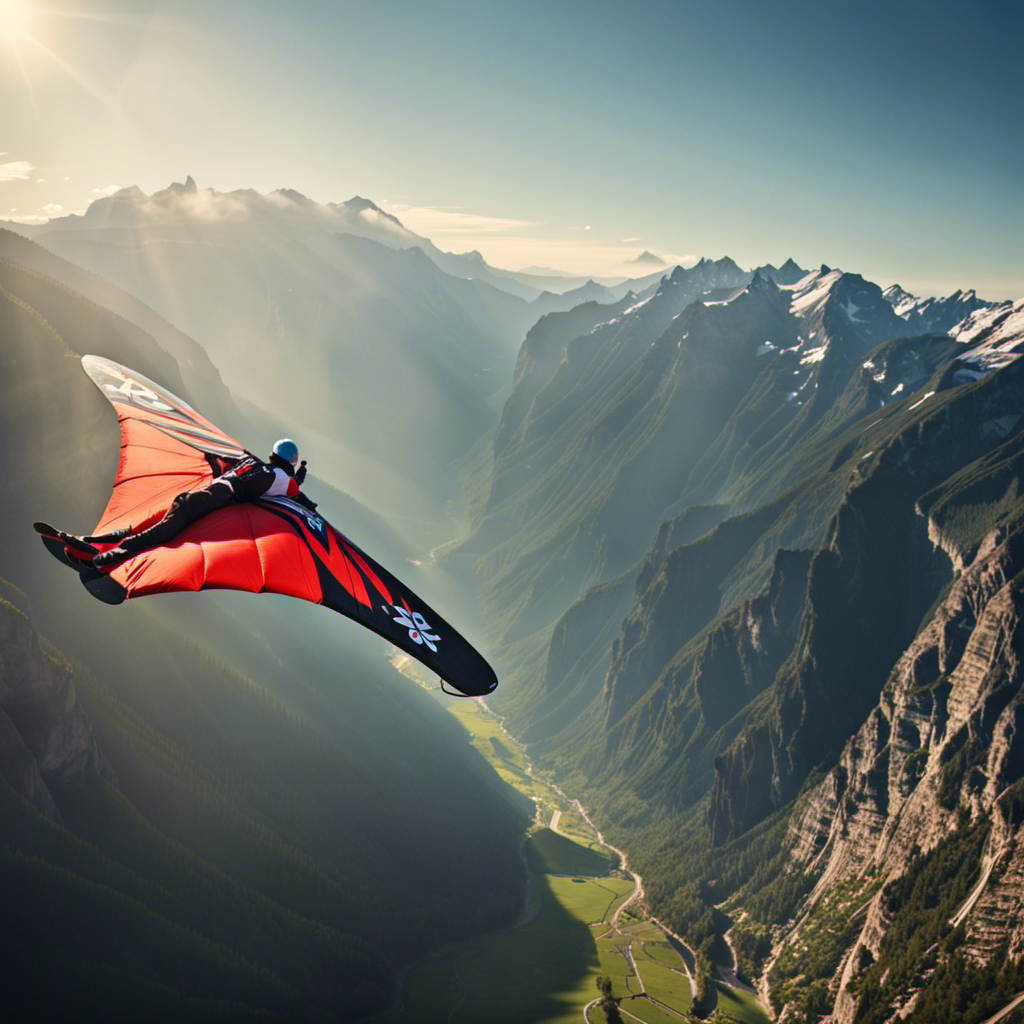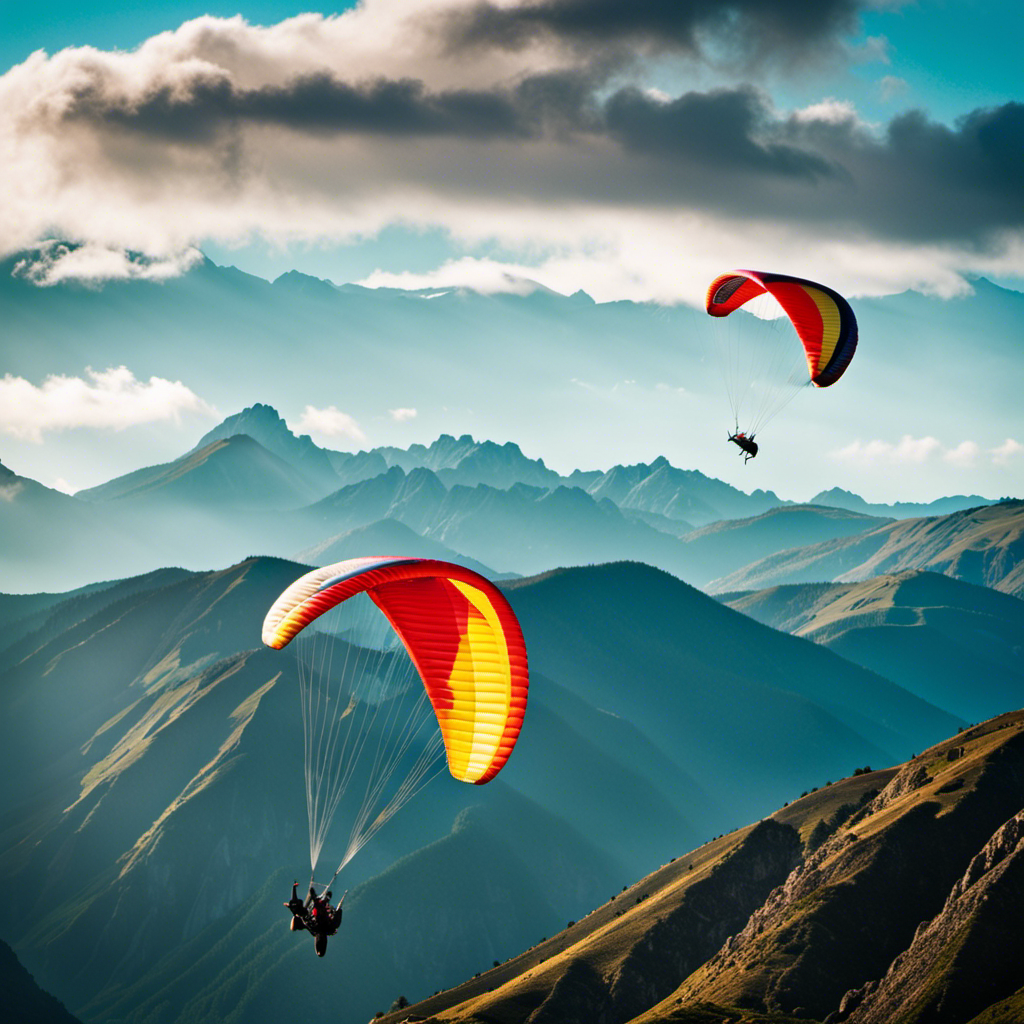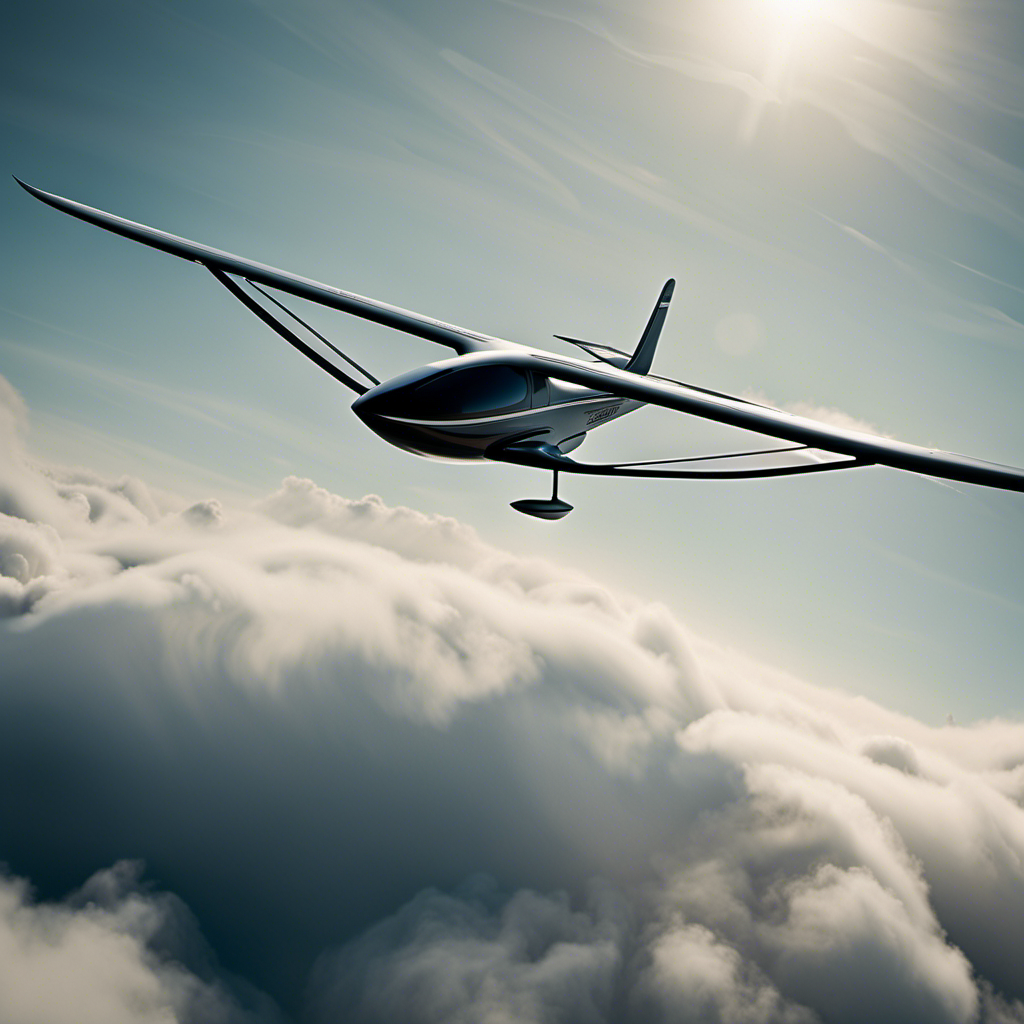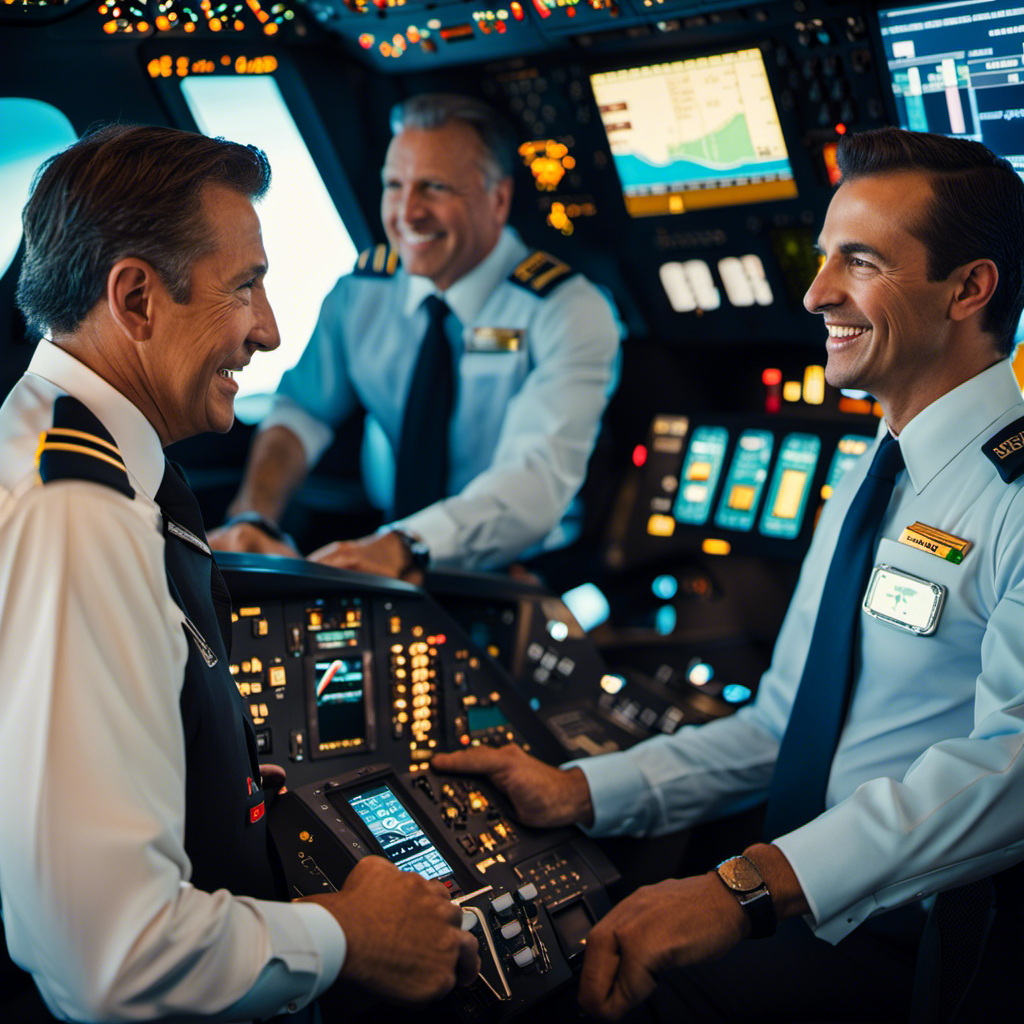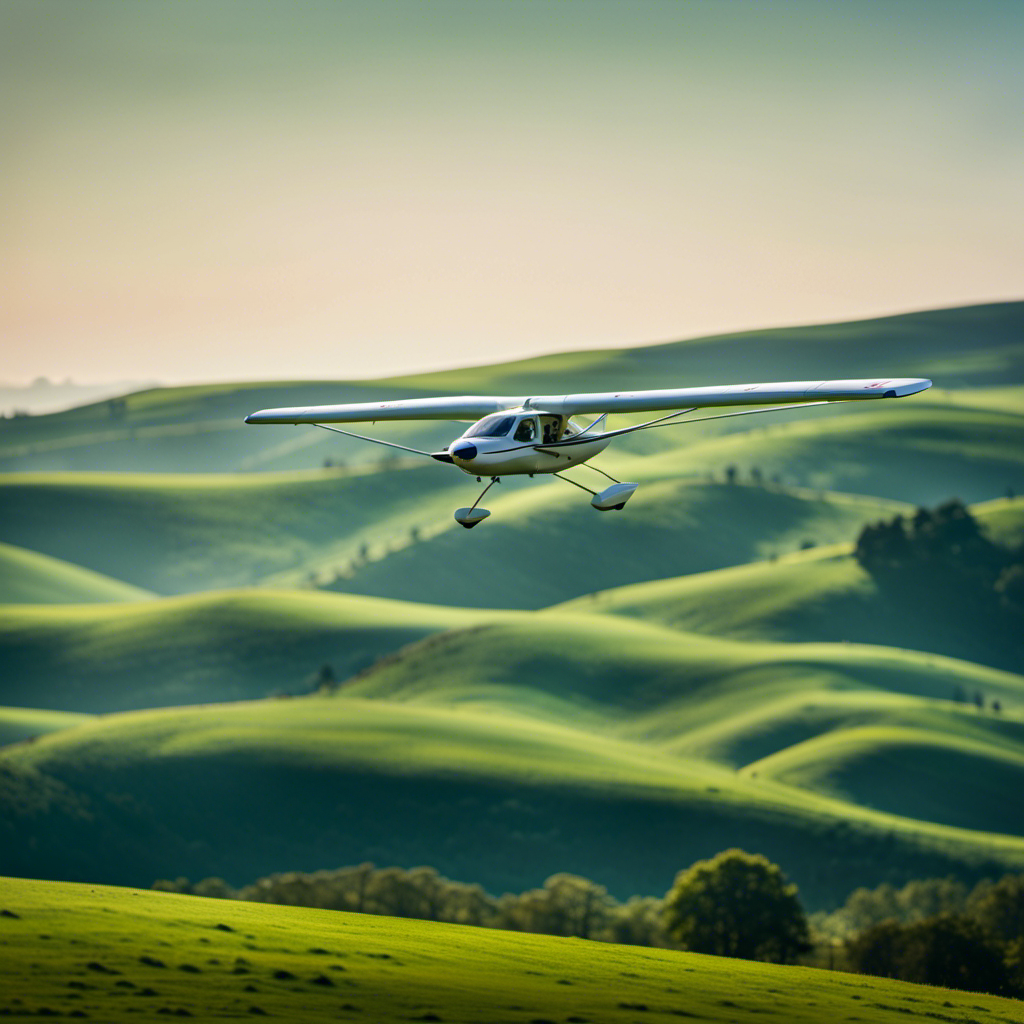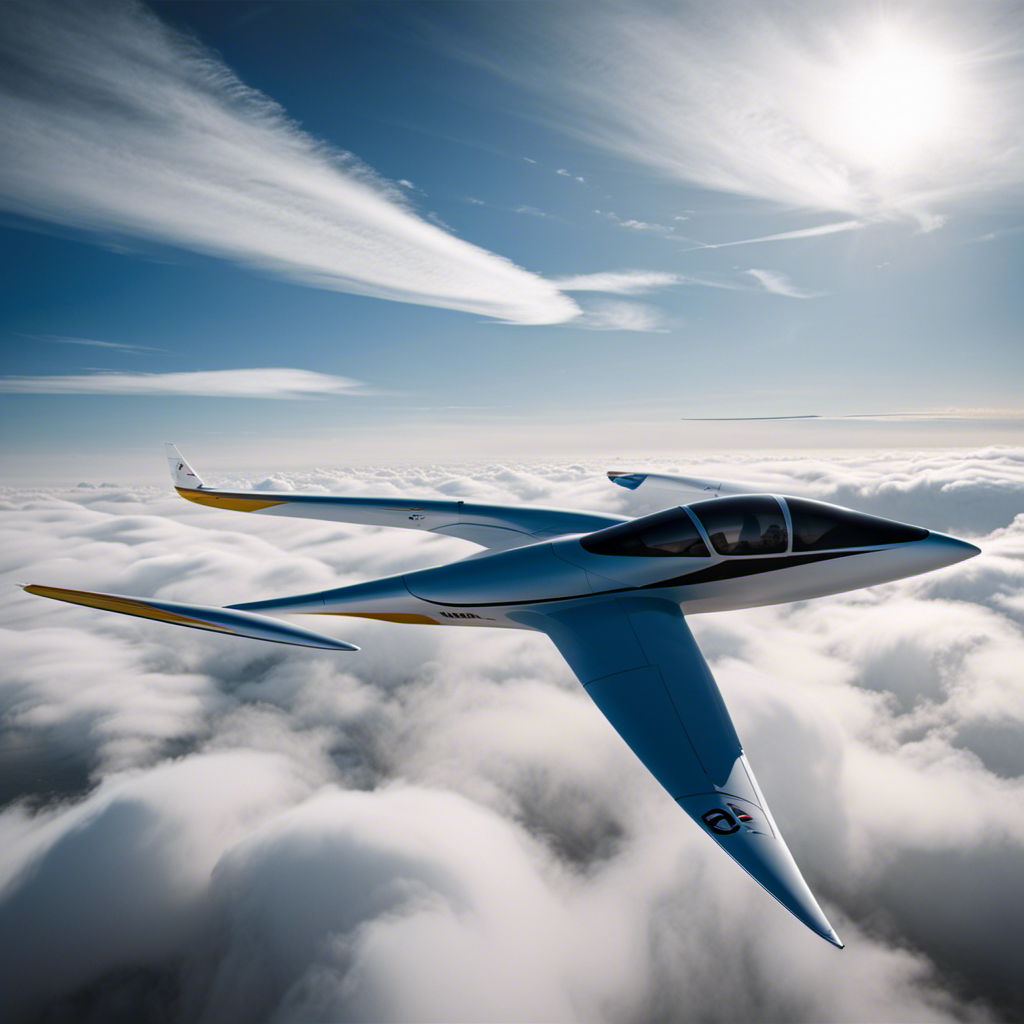People often say that one should live life to the fullest, and for those who enjoy high adrenaline activities like myself, wingsuit flying is the ultimate way to push limits. Participating in this thrilling sport enables me to soar through the sky, defying gravity and experiencing an unmatched rush of excitement.
Join me as I take you on an exhilarating journey into the world of wingsuit gliding. From understanding the history and equipment, to mastering advanced maneuvers and tricks, this guide has everything you need to embark on your own high-flying adventure.
Get ready to spread your wings and let the adrenaline take flight!
Key Takeaways
- Wingsuits have evolved over time, with advancements in materials and design leading to more efficient and aerodynamic suits.
- Proper equipment maintenance, safety measures, and regular gear checks are essential for wingsuit flying.
- Training and preparation involve physical fitness requirements, skill development, and mastering advanced flying techniques.
- Mental preparedness, focus, and risk management skills are crucial for wingsuit gliding.
The History of Wingsuit Gliding
Now, let’s take a look at the history of wingsuit gliding and how it has evolved over the years.
The evolution of wingsuit technology has been remarkable, allowing humans to experience the exhilaration of flying like never before. In the early days, wingsuits were rudimentary, consisting of basic fabrics that provided limited lift and control. However, as technology advanced, so did the wingsuits.
Innovations in materials and design led to the development of more efficient and aerodynamic suits, enabling gliders to achieve longer and faster flights.
Throughout history, there have been several famous wingsuit gliders who pushed the boundaries of this extreme sport. Names like Jeb Corliss and Alexander Polli are renowned for their daring flights and breathtaking stunts.
Understanding the equipment is crucial for a safe and successful wingsuit experience. So, let’s delve into the next section and explore the necessary gear and techniques.
Understanding the Equipment
First, you’ll need to familiarize yourself with the gear necessary for wingsuit flying. Understanding wing load is crucial in order to choose the right suit for your body weight and experience level. This refers to the ratio of your body weight to the surface area of the wingsuit.
Proper gear maintenance is also essential to ensure your safety. Regular inspections of your wingsuit, parachute, helmet, and other equipment are necessary to identify any wear and tear that could compromise their performance. Cleaning and storing your gear properly will help extend its lifespan.
Now that you understand the equipment and the importance of wing load and gear maintenance, let’s move on to the next section: training and preparation for wingsuit flying.
Training and Preparation
Before starting your training and preparation for wingsuit flying, it’s important to understand the risks and the physical demands of the sport. Wingsuit flying requires a high level of physical fitness and skill development. To give you a better understanding, let’s take a look at the physical demands and the skills you need to develop:
| Physical Demands | Skill Development | Mental Preparedness |
|---|---|---|
| Cardiovascular endurance | Body awareness and control | Focus and concentration |
| Strength and flexibility | Flight planning and navigation | Decision-making under pressure |
| Core stability | Aerodynamics and body positioning | Risk assessment and management |
| Balance and coordination | Emergency procedures | Resilience and adaptability |
| Endurance and stamina | Canopy control (for parachute deployment) | Confidence and self-belief |
As you can see, wingsuit flying requires a combination of physical fitness and skill development. It’s not just about jumping off a cliff and gliding through the air. It’s a sport that demands discipline, training, and mental preparedness. In the next section, we will discuss the safety measures and precautions you need to take to ensure a safe wingsuit flying experience.
Safety Measures and Precautions
To ensure a safe wingsuit flying experience, it’s important to familiarize yourself with the necessary safety measures and precautions. Here are some key safety protocols and emergency procedures to keep in mind:
-
Gear check before every flight:
-
Ensure that your wingsuit, helmet, and parachute are in good condition.
-
Double-check all straps and connections to make sure everything is secure.
-
Emergency procedures:
-
Practice emergency drills regularly to stay prepared.
-
Know how to deploy your parachute in case of a malfunction.
It’s crucial to prioritize safety and be prepared for any unforeseen circumstances while wingsuit flying. By following these safety protocols and being well-versed in emergency procedures, you can minimize risks and enjoy a thrilling yet safe experience.
Now, let’s transition to the next section and explore the importance of choosing the right location for wingsuit flying.
Choosing the Right Location
When selecting a location for wingsuit flying, it’s crucial to consider factors like weather conditions and geographical features.
Weather conditions play a significant role in ensuring a safe and enjoyable flight. Clear skies, minimal wind, and stable atmospheric conditions are ideal for wingsuit gliding. It’s important to avoid flying in extreme weather conditions such as storms or heavy rain.
Additionally, terrain suitability is essential to ensure a smooth and controlled flight. Choosing a location with ample open space, free from obstacles like trees or buildings, is crucial for a successful wingsuit flight. The terrain should also have suitable landing areas that are clear and unobstructed.
By carefully considering weather conditions and terrain suitability, you can maximize your chances of having a thrilling and safe wingsuit flying experience.
Now, let’s dive into the next section about proper body positioning and flying techniques.
Proper Body Positioning and Flying Techniques
Proper body positioning and flying techniques play a crucial role in ensuring a safe and successful wingsuit flight.
When it comes to body positioning, keeping a stable and streamlined posture is key. This means tucking your legs together and keeping your arms close to your sides. By minimizing drag, you’ll be able to maintain a consistent and controlled flight path.
As for flying techniques, it’s important to start with small, controlled movements. Gradually shift your weight and adjust your body position to maintain stability and control. By mastering these fundamental techniques, you’ll be ready to progress to more advanced maneuvers and tricks.
From barrel rolls to backflips, the possibilities are endless. So, let’s dive into the exciting world of advanced wingsuit flying and explore the thrilling tricks you can perform in the air.
Advanced Maneuvers and Tricks
After mastering the proper body positioning and flying techniques, it’s time to take your wingsuit gliding to the next level with advanced maneuvers and tricks. These techniques allow you to push the boundaries of what is possible in the air, performing thrilling aerial acrobatics that will leave you and your audience in awe. From barrel rolls to backflips, the possibilities are endless when it comes to showcasing your skills and creativity in the skies. To help you understand and practice these advanced techniques, I’ve created a handy table that outlines some of the most popular maneuvers and tricks in wingsuit gliding. So strap on your wingsuit and get ready to defy gravity in ways you never thought possible!
| Maneuver/Trick | Description |
|---|---|
| Barrel Roll | A 360-degree rotation around your longitudinal axis |
| Backflip | A backward somersault in mid-air |
| Tracking | Flying in a flat position to cover more horizontal distance and gain greater speed |
| Frontloop | A forward somersault in mid-air |
| Corkscrew | A twisting motion around both the longitudinal and vertical axes |
| Wingtip Drag | Touching the wingtips on the surface of the water or other objects to create dramatic visuals |
Now that you have a grasp of these advanced techniques, it’s time to focus on the mental preparedness and mindset required for successful wingsuit gliding.
Mental Preparedness and Mindset
When it comes to high-risk activities like wingsuit gliding, mental preparedness and mindset are crucial. Overcoming fear and anxiety is one of the first challenges to conquer.
Maintaining focus and concentration during flights is essential for safety and optimal performance. And utilizing visualization and mental rehearsal techniques can help improve skills and confidence.
In this discussion, we will explore these key points and delve into strategies for developing a strong mental game in wingsuit gliding.
Overcoming Fear and Anxiety
Don’t let fear and anxiety hold you back from experiencing the exhilaration of wingsuit gliding. Overcoming these emotions is key to building confidence and unlocking your potential in this thrilling sport. Here are three things to keep in mind as you face your fears:
-
Embrace the unknown: Stepping outside of your comfort zone can be intimidating, but it’s in these moments that we truly grow. Embrace the unknown and trust in your abilities.
-
Visualize success: Picture yourself soaring through the air, feeling the rush of the wind against your body. Visualizing success can help calm your nerves and boost your confidence.
-
Seek support: Surround yourself with a supportive community of fellow wingsuit gliders. Their encouragement and shared experiences can help you overcome your fears and build confidence.
Focus and Concentration
To enhance your performance in wingsuit gliding, it’s important to improve your focus and concentration.
Focus techniques can help you stay in the present moment and make split-second decisions while soaring through the air. One effective technique is mindfulness meditation, which involves focusing your attention on your breath or a specific sensation, and gently bringing it back whenever your mind wanders.
Another technique is visualization, where you imagine yourself gliding smoothly through the air, feeling the wind on your face and the rush of adrenaline.
By practicing these focus techniques regularly, you can improve your concentration and stay in the zone during your flights.
Now, let’s move on to the next section: visualization and mental rehearsal, where we will explore how to mentally prepare for your wingsuit gliding adventures.
Visualization and Mental Rehearsal
Visualization and mental rehearsal are effective techniques for preparing your mind for wingsuit gliding. As I gear up for my next wingsuit adventure, I find that visualizing myself soaring through the sky helps me build confidence and focus.
Here are some visualization techniques and positive affirmations that have proven beneficial for me:
- Close your eyes and imagine yourself gracefully gliding through the air, feeling the wind on your face.
- Visualize a successful takeoff, smooth flight, and a safe landing.
- Repeat positive affirmations such as ‘I am capable and confident in my abilities’ to boost self-belief.
- Picture yourself navigating through different terrains and obstacles with ease.
- Visualize the exhilaration and joy you will feel as you glide through the air like a bird.
With these visualization techniques and positive affirmations, I am able to mentally prepare myself for the thrill and joy of wingsuit gliding.
The excitement builds as I imagine the rush of adrenaline and the breathtaking views that await me in the next section.
The Thrill and Joy of Wingsuit Gliding
When it comes to wingsuit gliding, there is nothing quite like the exhilarating feeling of experiencing true freedom.
As I soar through the air, I can’t help but be amazed by the stunning beauty of nature that surrounds me.
And what makes this experience even more special is the camaraderie and sense of community that is built among fellow wingsuit gliders, as we support and encourage each other in this daring sport.
Experiencing True Freedom
Imagine soaring through the sky like a bird, feeling the rush of wind against your face and experiencing true freedom in every moment. That’s the incredible sensation of wingsuit gliding.
As I jump off the edge of a cliff or out of a plane, my heart races with true adrenaline. The moment I spread my wings and feel the fabric catch the wind, I’m transported into a world of soaring sensations. The speed and intensity of the flight is unlike anything I’ve ever experienced. It’s a rush that leaves me breathless and exhilarated.
But wingsuit gliding isn’t just about the thrill—it’s also about connecting with nature. As I glide through the air, I become one with the elements, feeling the raw power of the wind and witnessing the beauty of the world from a unique perspective.
Connecting with Nature
As I glide through the air, I can’t help but feel a deep sense of connection with nature. The wind rushes past my face, carrying with it the scents of the forest and the sound of birds singing in the distance. It’s a breathtaking experience that allows me to truly appreciate the beauty of the natural world.
Nature appreciation is at the core of wingsuit gliding. It’s not just about the thrill of flying, but also about immersing oneself in the environment and understanding our place within it. This sport encourages a deeper connection with nature, fostering a sense of respect and awe for the world around us.
In addition to personal fulfillment, wingsuit gliding also has a positive environmental impact. By promoting an appreciation for nature, it encourages individuals to become advocates for conservation and sustainable practices. It raises awareness about the fragility of our ecosystems and the importance of preserving them for future generations.
Building Camaraderie and Community
Joining this community allows you to connect with like-minded individuals who share your passion for adventure and the great outdoors. Building friendships and fostering teamwork are key aspects of this community, as we understand the importance of camaraderie in pursuing our shared love for wingsuit gliding.
When you join, you become part of a supportive network where you can meet fellow wingsuit enthusiasts, exchange tips and tricks, and even plan group flights. The bond formed through our common interests creates a sense of belonging and unity, enhancing the overall experience of wingsuit gliding.
Safety and Risk Management Resources
When it comes to participating in high-risk activities like wingsuit gliding, it’s crucial to prioritize safety and risk management.
In this discussion, we will explore three important aspects of ensuring a safe and secure wingsuit gliding experience.
Firstly, we will delve into the significance of joining professional organizations and obtaining certifications to enhance our knowledge and skills.
Secondly, we will examine the benefits of safety training courses that can equip us with essential techniques and strategies for mitigating risks.
Lastly, we will explore various injury prevention and recovery techniques that can help us stay in peak physical condition and bounce back from any potential accidents or setbacks.
Professional Organizations and Certifications
There’s no better way to establish your credibility in the wingsuit gliding community than by obtaining professional certifications through recognized organizations. Not only do these certifications showcase your commitment to safety and skill development, but they also open doors to professional networking opportunities within the community. By joining these organizations and participating in their certification programs, you gain access to a wealth of knowledge, resources, and connections that can enhance your wingsuit gliding journey.
Table: Professional Organizations and Certifications
| Organization | Certification |
|---|---|
| International Wingsuit Pilots Association (IWPA) | Wingsuit Pilot Certificate |
| United States Parachute Association (USPA) | Wingsuit Instructor Rating |
| European Wingsuit Association (EWA) | Wingsuit Flyer License |
| Australian Parachute Federation (APF) | Wingsuit Coach Accreditation |
| International Bodyflight Association (IBA) | Wingsuit Performance Certificate |
These organizations provide comprehensive training and evaluation programs that cover various aspects of wingsuit gliding, including flight techniques, safety procedures, and emergency protocols. By earning these certifications, you not only enhance your skills but also demonstrate your commitment to safe and responsible wingsuit gliding.
Transitioning into the subsequent section about ‘safety training courses,’ it is important to note that while professional certifications are valuable for skill development and networking, they should be complemented by specialized safety training courses.
Safety Training Courses
To ensure your safety and preparedness in the wingsuit gliding community, it’s important to invest in specialized safety training courses alongside professional certifications and memberships.
These courses provide crucial knowledge on emergency procedures and first aid, equipping you with the skills needed to handle any potential accidents or injuries that may occur during your wingsuit flights. From learning how to respond to a parachute malfunction to administering basic first aid techniques, these courses cover a wide range of essential topics.
By participating in these training programs, you not only enhance your own safety, but also contribute to a safer wingsuit gliding community as a whole.
Now that we’ve covered the importance of safety training, let’s delve into injury prevention and recovery techniques.
Injury Prevention and Recovery Techniques
It’s crucial to prioritize injury prevention and recovery techniques in order to maintain your safety and well-being while participating in wingsuit gliding. To prevent injuries, here are some techniques to keep in mind:
-
Proper warm-up and stretching: Stretching helps to increase flexibility and reduce the risk of muscle strains or tears. A thorough warm-up session prepares your body for the intense physical activity.
-
Strengthening exercises: Building strength in the core, legs, and upper body can help improve stability and control during flight. This can be achieved through weightlifting, resistance training, and bodyweight exercises.
For recovery after a flight, consider these rehabilitation exercises:
-
Low-impact cardio: Engaging in activities like swimming or cycling helps to promote blood circulation, relax muscles, and reduce soreness.
-
Stretching and foam rolling: These techniques aid in muscle recovery and help to alleviate any tightness or stiffness.
Frequently Asked Questions
Are there any age restrictions for participating in wingsuit gliding?
Yes, there are age limits in place for wingsuit gliding. Safety measures are important, so most organizations require participants to be at least 18 years old to ensure they have the necessary maturity and physical capabilities.
What is the average cost of purchasing a wingsuit and the necessary equipment?
The average cost of purchasing a wingsuit and the necessary equipment can range from $3,000 to $10,000. This includes the wingsuit, helmet, altimeter, parachute, and other safety gear. It’s important to invest in high-quality equipment for a safe and enjoyable wingsuit gliding experience.
Can wingsuit gliding be practiced in any weather conditions?
In wingsuit gliding, weather limitations are crucial for safety. As the saying goes, "Better safe than sorry." It is important to check weather conditions and take necessary precautions to ensure a successful and safe flight.
Are there any specific physical fitness requirements for wingsuit gliding?
Physical preparation for wingsuit gliding requires a rigorous training regimen. It involves building strength, endurance, and flexibility to handle the demands of the sport. A well-rounded fitness routine is crucial to ensure a safe and enjoyable wingsuit flying experience.
Are there any legal permits or licenses required to participate in wingsuit gliding?
Legal requirements for wingsuit gliding include obtaining the necessary permits and licenses. Safety regulations must be followed to ensure a safe and enjoyable experience. It is important to adhere to these guidelines to protect yourself and others.
Conclusion
As I reflect on the exhilarating world of wingsuit gliding, I can’t help but be filled with awe and gratitude. The history of this sport is a testament to human ingenuity and our unyielding desire to soar through the skies.
With the right equipment, training, and preparation, anyone can experience the thrill of wingsuit gliding. But amidst all the excitement, it is crucial to remember the importance of safety and risk management.
So, my fellow adventurers, let us spread our wings and embrace the joy of wingsuit gliding, always mindful of the power and beauty that lies within.
With a heart that soars as high as the skies, Aria, affectionately known as “Skylark,” is the driving force behind Soaring Skyways. Her journey into the gliding world began as a young dreamer gazing up at the soaring birds, yearning to experience the weightlessness and freedom they embodied. With years of experience both in the cockpit and behind the scenes, Aria’s commitment to the gliding community is unwavering.
